Acrylic markers blend paint and pen techniques for eye-catching artwork. Artists can create bold, opaque colors or dilute them with water for watercolor-like effects. The markers offer precise control for details while maintaining paint’s vibrant qualities. Mix colors on a palette, layer for depth, or use glazing techniques for transparent effects. When artwork looks flat, try layering multiple colors or adding highlights with white paint pens. These versatile tools open a world of creative possibilities beyond traditional mediums.
Key Takeaways
- Acrylic markers combine the precision of pens with the blending capabilities of paint for versatile artistic expression.
- Adding water to acrylic markers creates transparent washes and watercolor effects while maintaining vibrant colors.
- Glazing techniques layer transparent colors to build depth and complexity in marker drawings.
- Mixing custom colors on a palette enhances artwork with unique shades not available in standard marker sets.
- Highlighting with white paint pens transforms flat drawings into dynamic pieces with dimensional effects.
Getting Started: Essential Materials for Acrylic Marker Artwork
Every successful acrylic marker artist knows that having the right materials can make all the difference between a frustrating experience and a creative breakthrough!
When diving into this vibrant medium, start with Claire Fontaine paint on white mixed media paper—it’s super versatile and works amazingly with different techniques you’ll want to try.
For mixing gorgeous colors, Jack Richardson’s gray matters paper palette pad is a game-changer!
You’ll definitely want to grab Amsterdam acrylic markers and adding 5000 markers for an awesome rainbow of color options.
Don’t forget a King Art premium white nylon round brush for blending, and a Faber-Castell colored kneadable eraser to whisk away pencil marks.
With these tools in your art kit, you’re totally ready to create mind-blowing acrylic marker masterpieces!
Understanding Marker Properties: Opacity and Flow
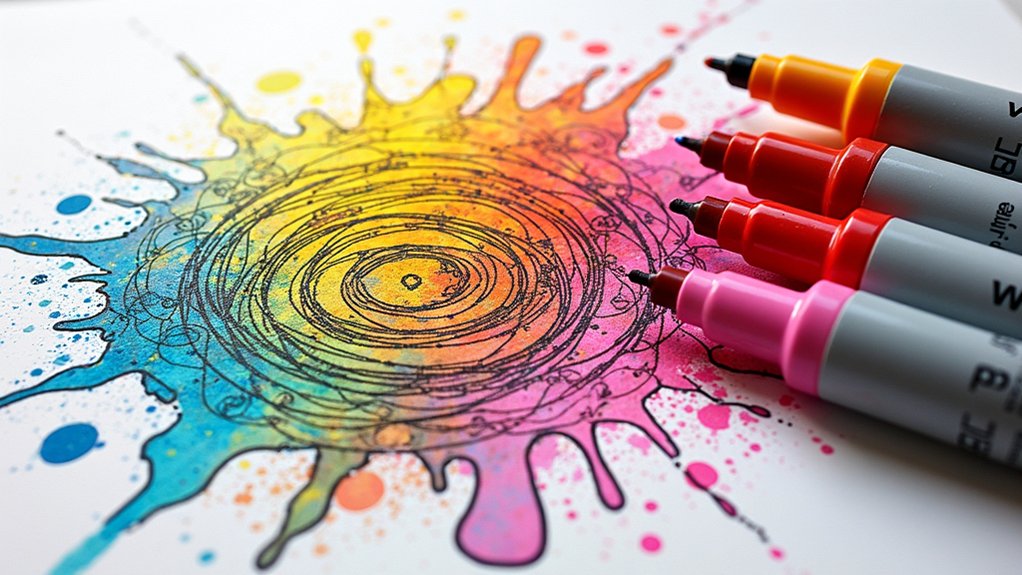
Now that your art supply collection is ready, let’s explore what makes acrylic markers so special! The magic lies in their incredible opacity and smooth flow. These markers pack a punch with vibrant colors that completely cover whatever surface you’re working on, no matter how dark!
| Property | Characteristic | Creative Benefit |
|---|---|---|
| Opacity | Covers surfaces completely | Bold, vivid artwork |
| Flow | Ink-like consistency | Precise control for details |
| Versatility | Water-dilutable | Can create watercolor effects |
The ink-like flow of acrylic markers gives you amazing control for fine details, while still letting you blend colors together like paint. Want to cover a larger area? Just adjust the valve and guard to increase paint flow—instant coverage! You can even add water to create see-through washes that look super professional!
Watercolor-Like Techniques With Acrylic Markers
Many acrylic marker enthusiasts discover a delightful surprise when they first add water to their artwork—magical watercolor effects that transform ordinary drawings into stunning masterpieces!
By diluting the pigment with a touch of water, these versatile acrylic paint pens create transparent layers that blend together like a dream.
Artists can achieve incredible depth by dropping concentrated color into wet areas, watching as the pigments dance and merge. The glazing technique, where colors are layered one over another, creates rich, complex effects that simply pop off the page!
For even more variety, try mixing colors on a palette first.
This hybrid approach combines the precision of marker lines with paint-like fluidity, making these tools perfect for mixed media projects where both control and spontaneity matter.
Color Mixing Strategies for Depth and Dimension
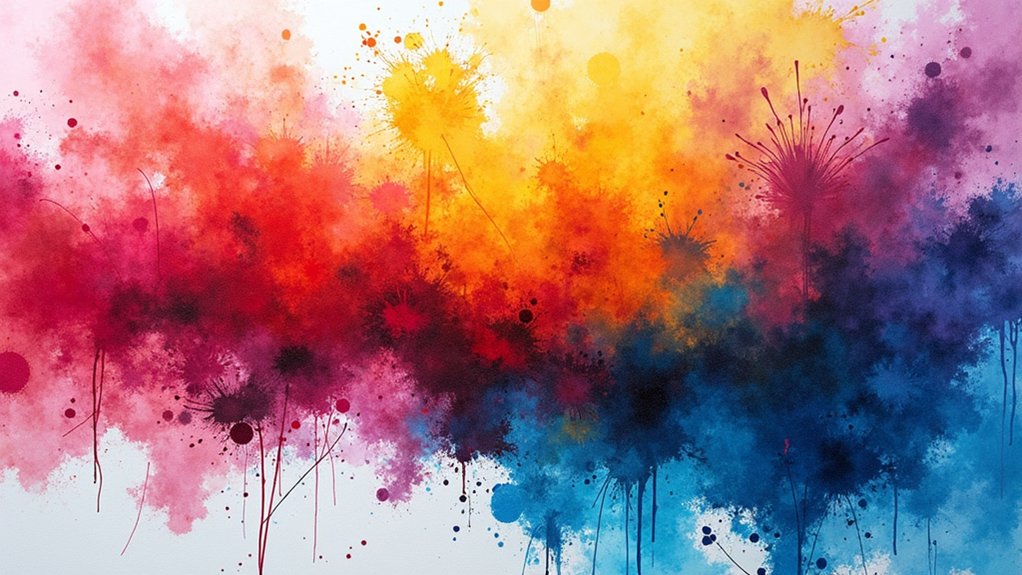
While watercolor effects create stunning fluidity in acrylic marker art, mastering color mixing takes these drawings to incredible new heights! Artists can blend directly on their palette, creating that’s truly unique and dimensional. By applying concentrated color to wet areas, the pigments dance together in ways that bring scenes to life!
| Technique | Effect | Best For |
|---|---|---|
| Palette Mixing | Rich variations | Sceneries |
| Wet Blending | Seamless gradients | Skies & water |
| Glazing | Transparent depth | Portraits |
Don’t be afraid to layer different shades when drawing trees or flowers—this prevents that flat, boring look! Try diluting your markers with a tiny bit of water for those see-through layers that make everything pop! Experimentation is key to discovering your personal style.
Marker Hacking: Maximizing Your Tools
Uncover the hidden potential of your acrylic markers through simple hacking techniques that professional artists swear by!
By unscrewing the guard and valve, artists can access more paint for varied applications that go beyond typical line work. This marker hacking trick transforms a simple tool into a versatile art supply!
Transform ordinary markers into extraordinary tools by freeing paint from its plastic prison—your art deserves this versatile upgrade!
For covering larger areas, try using pliers to disassemble the marker and pour the paint directly onto a palette.
Don’t worry—you can put everything back together afterward! This clever hack lets artists mix custom colors right on the palette, creating one-of-a-kind shades that add incredible depth to drawings.
Plus, applying concentrated color to wet surfaces creates gorgeous watercolor-like blends that’ll make your friends ask, “How did you do that?!”
Layering Methods for Texture and Dimension

Artists can bring their acrylic marker drawings to life using different layering techniques that add amazing texture and dimension.
Paint pooling creates depth by allowing colors to gather and blend in specific areas, while cross-direction stroke patterns build rich textures that catch the eye from multiple angles.
Combining wet and dry application methods creates dramatic contrasts that make drawings pop off the page, giving even simple designs a professional, multi-dimensional appearance.
Paint Pooling Technique
Creating magic with acrylic markers begins with the enchanting paint pooling technique. Artists create small puddles of concentrated color on their palette, then blend and dilute these pools to control paint flow for dreamy watercolor effects.
When concentrated pigment meets wet areas on the artwork, colors dance together in beautiful, seamless blends that bring the piece to life.
For incredible results with this technique:
- Start with a small pool of concentrated marker ink on a non-porous palette
- Add tiny drops of water to adjust transparency while maintaining vibrant color
- Apply to your artwork in layers, allowing each to dry for spectacular depth
Cross-Direction Stroke Patterns
While simple lines and shapes can create beautiful art, cross-direction stroke patterns reveal an entirely new dimension in acrylic marker drawings.
Artists who apply strokes in different directions—horizontal, vertical, and diagonal—create amazing texture and depth in their work.
This cross-directional technique works beautifully with layering methods like glazing, where see-through colors go over dried layers without hiding what’s underneath.
Wow! The magic happens when concentrated color is added to wet areas, allowing colors to blend and dance across the canvas. It’s like giving your artwork its own personality!
Experimenting with various shades in cross-directional applications prevents that boring “flat look” that nobody wants.
Instead, the artwork pops with energy and dimension, making viewers want to reach out and touch it!
Wet-Dry Contrast Effects
The magic of wet-dry contrast brings acrylic marker drawings to life! Artists can create stunning visual effects by applying concentrated marker color to wet areas, where the pigment spreads and blends seamlessly.
When these fluid sections meet dry areas, the boundary creates a fascinating interplay between transparent and opaque elements.
To achieve eye-catching wet-dry contrast effects:
- Layer strategically – Apply thin, transparent glazes over dried areas to build depth while maintaining distinct wet-dry boundaries.
- Mix colors on the palette first for wet areas, but use markers directly for crisp dry sections.
- Alternate wet and dry applications throughout your process, allowing certain sections to dry completely before adding more layers.
This technique is like having a secret artistic superpower! The contrast between flowing wet areas and precise dry marks creates dimension that practically jumps off the page.
Adding Highlights and Details With Paint Pens
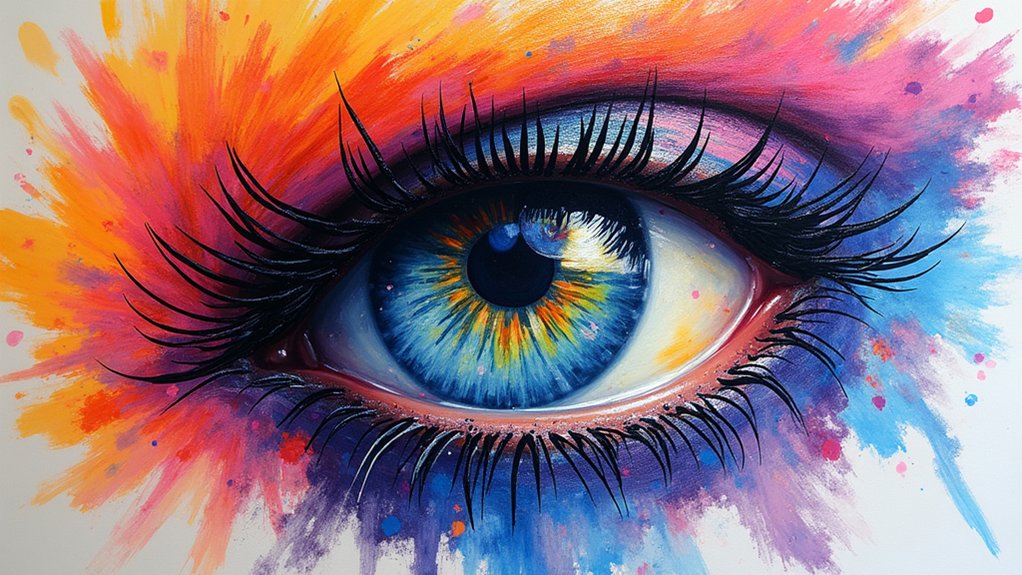
Acrylic marker drawings burst to life when artists add highlights and details using paint pens. A white paint pen becomes your secret weapon for creating those eye-popping bright spots that make your artwork pop!
Unleash the magic of white paint pens to elevate your acrylic marker art with dazzling highlights that captivate viewers!
By adding lighter colors strategically, artists create depth and dimension that transforms flat drawings into dynamic pieces. Layering different colors in your highlights adds interest and prevents your work from looking boring or one-dimensional.
After applying your initial marker layers, grab those paint pens and carefully add those final touches! Burnt sienna and moss green markers can emphasize shapes and textures, making everything look more realistic.
Don’t be afraid to experiment with different techniques like glazing or blending. The magic happens when you combine methods—your acrylic markers create the foundation, while paint pens add that extra sparkle that makes viewers say “Wow!”
Mixed Media Applications and Possibilities
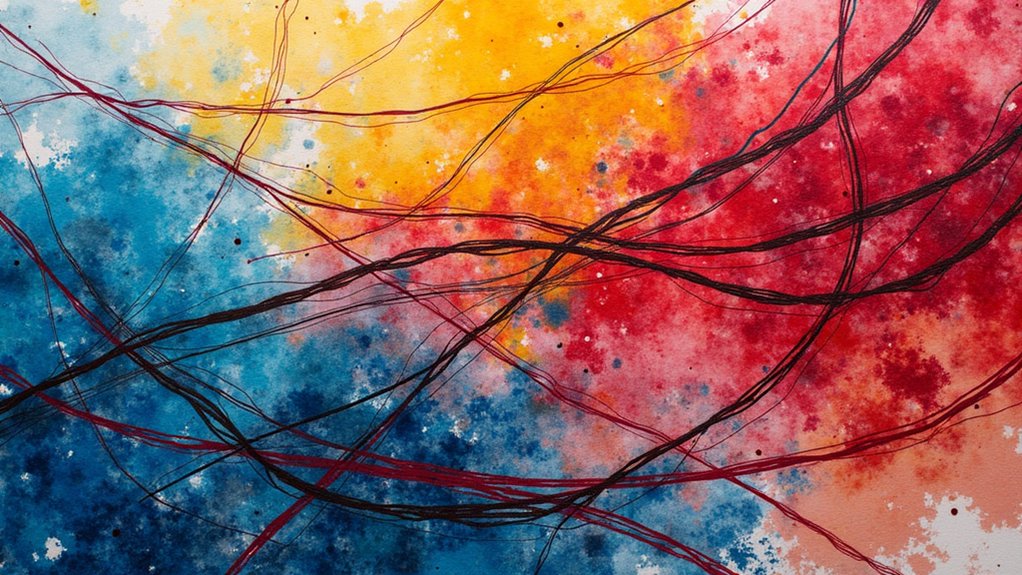
Beyond the realm of single-medium artwork, mixed media applications open up a world of exciting possibilities for acrylic marker enthusiasts!
By combining acrylic markers with traditional watercolor techniques, artists can create stunning compositions with both opaque and transparent qualities. The versatility of these markers truly shines when artists experiment with different surfaces and complementary materials.
- Color Magic – Use a palette to mix custom shades, creating a personal rainbow that makes your artwork uniquely yours!
- Layer It Up – Add depth by layering concentrated colors for eye-popping details over softer background washes.
- Get Experimental – Extract paint from markers for larger areas, then blend with water for amazing watercolor-like effects that still maintain crisp edges where needed.
These mixed media approaches transform simple drawings into multi-dimensional artistic expressions that wow viewers!
Troubleshooting Common Issues in Acrylic Marker Art
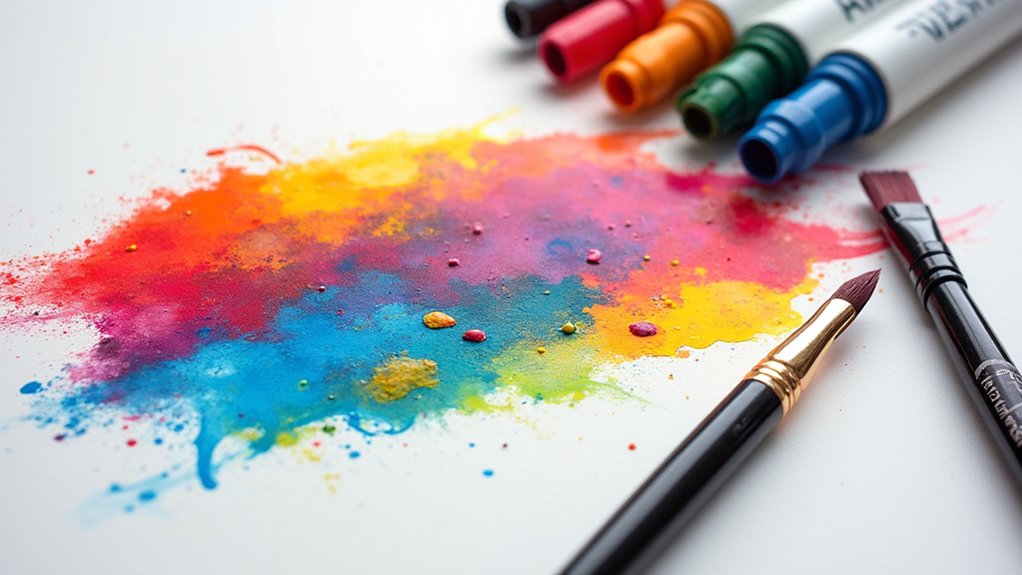
While creating vibrant mixed media masterpieces is exciting, even experienced artists occasionally run into snags with their acrylic marker projects!
Troubleshooting common issues starts with clogged markers. Simply unscrew the guard and valve to clean them or extract paint for larger areas. Markers running dry? Reassemble them after paint extraction to keep the fun rolling!
Frustrated by flat-looking artwork? Layer multiple colors on stems, leaves, and details to create amazing depth that pops off the page!
For smooth applications that blend like a dream, try diluting paint with water on a palette. This watercolor-like technique works wonders!
And remember, mixing colors gets messy fast. Using a dedicated palette pad, like Jack Richardson’s gray matters paper, prevents those muddy disappointments and keeps your colors vibrant and true!
Frequently Asked Questions
What Is the Difference Between Acrylic Markers and Paint Pens?
Acrylic markers offer greater versatility with water-dilutable paint that allows blending and watercolor effects, while paint pens have thicker consistency for precise application and less adaptability once applied.
How Do You Blend Acrylic Paint Markers?
Blending techniques for acrylic paint markers involve creating transparent layers using water, applying glazing on wet areas, mixing colors on a palette, and gradually building up layers for smooth shifts.
What to Use Acrylic Paint Pens For?
Artists use acrylic paint pens for detailed artwork, lettering, mixed media projects, and customizing objects. These versatile tools excel in art techniques requiring precision, bright colors, and permanent markings on various surfaces.
Is Posca an Acrylic Marker?
Yes, Posca is an acrylic marker that utilizes water-based acrylic paint. This provides exceptional marker versatility for different surfaces while maintaining the permanent, vibrant qualities of traditional acrylics.
Conclusion
Acrylic markers open a world of artistic possibilities that blend the best of painting and drawing. By experimenting with layers, mixing techniques, and different surfaces, artists can create truly one-of-a-kind pieces that pop with personality. Don’t be afraid to make mistakes—they often lead to happy accidents! With practice and patience, your acrylic marker skills will grow, turning simple doodles into vibrant masterpieces that showcase your unique creative voice.


Leave a Reply